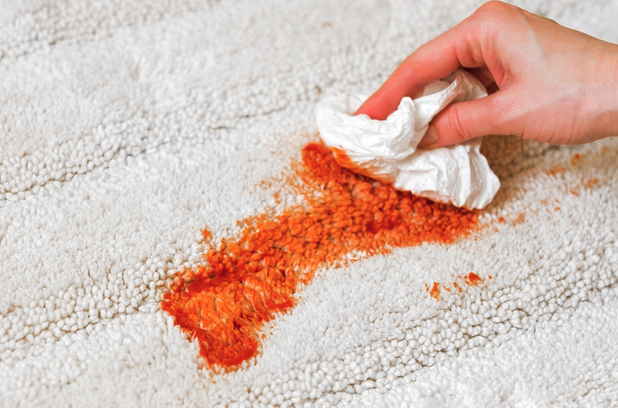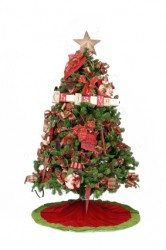Stubborn stains on clothes or upholstery are a universal headache, and there’s no shortage of DIY solutions promising to banish them. But with so many “hacks” floating around, it’s tough to tell which ones actually work and which could make things worse. Here’s our guide to tried-and-true stain removal hacks.
Different Types of Stains and Why They Matter
Knowing what kind of stain you’re dealing with can make all the difference in finding the right fix. Most common stains fall into a few main categories, and each one responds best to specific methods.
- Oil-Based (think salad dressing, butter, or greasy fingerprints): These can be especially tricky because oils cling to fabrics. To lift these effectively, you’ll want something that breaks down grease—think dish soap or a sprinkle of baking soda.
- Water-Based (juice, soda, or mud): These tend to dissolve more easily in water, but you’ll need to work quickly. Blotting with a bit of white vinegar or club soda can work wonders, especially for darker liquids.
- Protein-Based (blood, sweat, or dairy): Protein spots are sensitive to temperature. Using cold water helps lift them out without causing them to set, while a dab of hydrogen peroxide can help for tougher cases.
- Dye or Pigment (ink, lipstick, or wine): These are often the most challenging. Since they involve color pigments, they require special attention. Rubbing alcohol or even a bit of hand sanitizer can help dissolve fresh ink or makeup marks.
The secret to success often lies in identifying what caused the mark, so you’re not just guessing or making it worse.
Stain Removal Hacks That Really Work (Backed by Experience)
You don’t need to involve harsh chemicals or complex solutions. Here’s how to handle some of the most common offenders with simple, effective methods—and why they work.
Grease and Oil Stains
Spots from cooking oils, butter, or even skincare products cling to fabrics because oil particles bind tightly to fibers. To combat these, start with a drop of dawn dish soap, which is designed to cut through grease.
How to Do It:
- Apply a small amount of dish soap directly onto the grease mark, rubbing it gently with your fingers or a soft cloth.
- Let it sit for a few minutes to break down the oils.
- Rinse with warm water (not hot) and check if the spot has lifted. Repeat as needed.
- For extra absorption, sprinkle baking soda over the area and let it sit for 10-15 minutes before rinsing again. Baking soda works by absorbing any remaining oils from the fabric.
Red Wine Stains and Coffee Spills
These dark, tannin-based spots are notorious for setting fast, especially in natural fibers like cotton and linen. The carbonation in club soda and the acidity in white vinegar help lift pigments from fabrics without damage.
How to Do It:
- Blot the stained area immediately with a clean cloth to soak up as much liquid as possible.
- Pour club soda and diluted white vinegar over the area, letting the fizz or acidity start lifting the pigment.
- Blot again. If any color remains, sprinkle a generous amount of salt over the damp area to absorb the rest.
- Let the salt sit for 5–10 minutes, then gently brush it off.
- Rinse with cold water, and avoid using hot water or a dryer until it’s completely gone to prevent setting.
Blood Stains
Blood can be one of the trickiest to handle since it’s protein-based. Using hot water will cook the proteins, making them “set” into the fibers. For that reason, cold water is key, along with hydrogen peroxide, which breaks down blood cells on a chemical level.
How to Do It:
- Rinse the spot with cold water, gently rubbing the fabric against itself to loosen particles.
- If any residue remains, dab a small amount of hydrogen peroxide onto the spot. You’ll see it fizz, which means it’s breaking down the proteins.
- Blot with a clean cloth until the area lightens, and rinse with cold water again. If the fabric is delicate, use a diluted solution of peroxide.
Ink Stains
Ink can feel permanent, but rubbing alcohol acts as a solvent that dissolves ink particles. This solution works best on fresh marks, and it’s a great option for clothing and even some upholstery.
How to Do It:
- Dip a cotton swab or cloth in rubbing alcohol and gently dab it onto the ink, starting from the edges to prevent spreading.
- Continue dabbing gently, rotating the cloth to a clean area as the ink lifts out.
- Once the mark lightens, rinse with cold water. Avoid pressing too hard or rubbing, as this can cause the ink to spread.
Grass Stains
Grass contains natural pigments that are tough to lift, but white vinegar and baking soda make a powerful combo. Vinegar’s acidity helps break down the chlorophyll in grass, while baking soda adds a bit of scrubbing power.
How to Do It:
- Apply a small amount of white vinegar to the grass mark and let it sit for about 5 minutes.
- Sprinkle a bit of baking soda over the vinegar, creating a gentle scrubbing paste.
- Gently scrub with an old toothbrush or a cloth until you see the mark fading, then rinse with cold water.
- Repeat if needed, but avoid using hot water until the spot is fully lifted, as it can set the green pigments.
Sweat Stains
Sweat and even deodorant often leaves behind yellowish marks, especially in the underarm area of light-colored clothing. Lemon juice and baking soda make a great team here, helping to neutralize both the oils and the proteins in sweat.
How to Do It:
- Squeeze lemon juice directly onto the sweat mark and let it sit for about 10 minutes.
- Sprinkle baking soda over the lemon juice, then use a cloth or toothbrush to gently scrub the area.
- Rinse with cold water and repeat as needed. The acidity of lemon juice breaks down the oils, while baking soda helps scrub the remaining residue out.
When to Call a Professional Dry Cleaner
Even with the best DIY efforts, some fabrics are best left to pros like Classic Cleaners. Here’s when calling in expert cleaners is the smartest move.
Delicate or Expensive Fabrics
Sensitive materials like silk, wool, and cashmere can react badly to home treatments. Harsh chemicals or scrubbing can cause discoloration or damage. We know how to handle delicate fabrics and use gentle, targeted solutions that won’t harm the material, ensuring the fabric stays intact and looks its best.
Deeply Set Stains
If a spot doesn’t budge after repeated attempts, it’s likely embedded deeply in the fibers. This is common with thicker materials like upholstery or carpets. We have access to powerful equipment that penetrates fabric layers and removes embedded spots effectively, especially useful for high-traffic items.
Persistent Odors
Food, pet soils, and smoke can leave lingering smells that simple treatments might not remove. Large items like carpets or couches often absorb these odors deeply. Our team use specialized deodorizing solutions and equipment like steam cleaners to remove smells at the source, leaving fabrics fresh and odor-free.
High-Value or Sentimental Items
For costly or sentimental pieces, like a wedding dress or family heirloom, the risk of DIY cleaning isn’t worth it. Improper treatment can lead to irreversible damage. Classic Cleaners use eco-friendly methods and gentle handling to preserve valuable items, extending their lifespan and maintaining their quality.
Discover Spotless Results with Classic Cleaners!
These cleaning hacks make it easy to tackle unexpected spots with confidence. And if you’re ready to experience the difference that expert care can make—whether it’s for your favorite garments, household items, or even a wedding dress—Classic Cleaners is here for you. Visit us at one of our 18 convenient locations or join our Convenience Club for the ultimate hassle-free experience. Your clothes deserve the best, and so do you.
For more cleaning tips, visit our blog to keep your wardrobe and home items looking their best!




